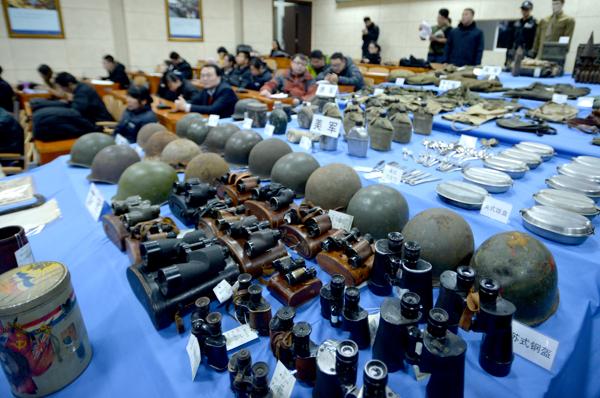
Relics of the Japanese aggression against China are exhibited in the Memorial Hall of the Victims of the Nanjing Massacre by Japanese Invaders on Dec 8 in Nanjing, Jiangsu province.[Photo/China Daily]
The Memorial Hall of the Victims of the Nanjing Massacre by Japanese Invaders exhibited 7,602 newly collected relics of the Japanese aggression on Dec 8.
The relics, collected from 14 countries, include photos, books and Japanese army munitions. They reveal the crimes of the Japanese army during the War of Resistance against Japanese Aggression (1937-45), such as the Nanjing Massacre, sexual violence and the use of poison gas, according to the memorial hall.
“In 2014, we sent workers to collect relics across the country and the world,” said Zhu Chengshan, the curator. “In 2014, with many people’s help, we collected the largest number of relics in a year.”
According to the hall, 1,092 relics were donated by the United States, and more than 600 were collected in Japan.
“As participants in history, the relics tell their own stories and present to the audience the original look of history,” Zhu said. “Though they represent only moments in the fabric of history, the relics are irreplaceable.”
Zhu said the memorial hall’s workers collected more than 400 bombs this year that were used by the Japanese army during the war in Northeast China. They also found a mustard gas bomb in Yunnan province, tangible evidence that poison gas was used by the Japanese army.
Zhang Guangsheng, a collector who came from Shenyang, Liaoning province, to Nanjing to donate 16 relics, said he wants more people to know what happened in the war.
“The relics may help people understand the cruelty of war and value peace more than ever,” said Zhang.
Since 2007, Zhang has collected more than 3,200 relics for the memorial hall. In 2014, he donated 16 wooden bowls, lacquered boxes and cosmetics bottles used by “comfort women”-a euphemism for sex slaves-at the Northeast Comfort Station.
Pu Jindao, chairman of Jiangsu Sugang Shipbuilding Company, donated a gunboat used by the Japanese army in rivers, the largest artifact yet in the hall’s collection.
The hall will further organize scholars to research the relics and exhibit them.
On Dec 13, China will mourn the victims of the Nanjing Massacre in the provincial capital. In February, the top legislature designated Dec 13 as a day or mourning for the victims and one of two national memorial days. The other, on July 7, marks the victory in the war.
In December 1937, Japanese invaders massacred roughly 300,000 Chinese civilians and unarmed soldiers in six weeks after capturing China’s former capital.
